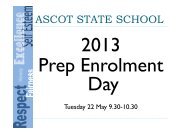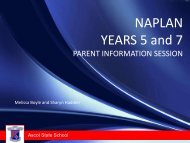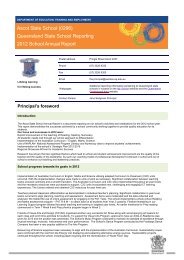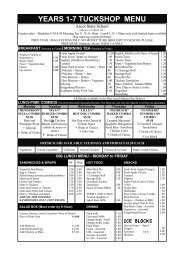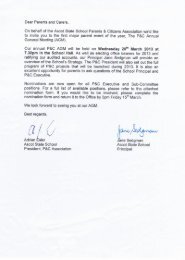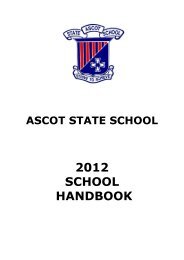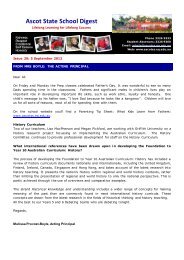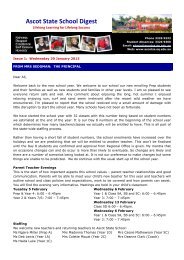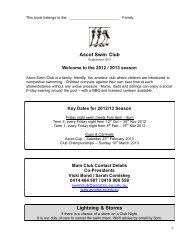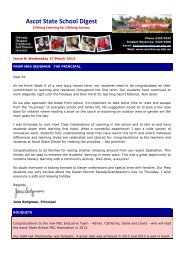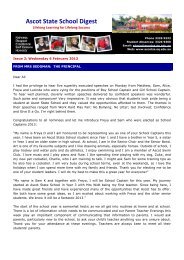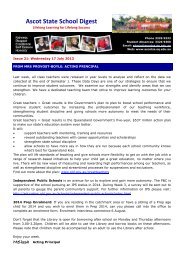Dimensions of Learning (DOL) - Ascot State School
Dimensions of Learning (DOL) - Ascot State School
Dimensions of Learning (DOL) - Ascot State School
You also want an ePaper? Increase the reach of your titles
YUMPU automatically turns print PDFs into web optimized ePapers that Google loves.
<strong>Ascot</strong> <strong>State</strong> <strong>School</strong><br />
ENRICHMENT PROGRAM<br />
and<br />
DIMENSIONS OF LEARNING<br />
Presenter<br />
Angela Dawson
DoL AND ENRICHMENT<br />
A FOCUS ON THINKING<br />
• KNOWLEDGE IS POWERFUL!<br />
• IN ORDER TO USE THAT KNOWLEDGE<br />
POWERFULLY YOU NEED THE ABILITY TO<br />
THINK!<br />
• THINKING PROVIDES THE SOFTWARE FOR<br />
THE MIND.<br />
• HIGHER ORDER THINKING ALLOWS<br />
STUDENTS’ MEMORY TO BE USED<br />
EFFECTIVELY.
How’s your thinking?<br />
If the day before the day before yesterday was<br />
Tuesday, what is the day after the day after tomorrow?
Solution<br />
Tues Wed Thur Fri Sat Sun Mon<br />
DB DB<br />
yesterday<br />
DB<br />
yesterday<br />
yesterday today tomorrow DA<br />
tomorrow<br />
DA DA<br />
tomorrow
THINKING STRATEGIES<br />
To engage in higher order thinking such as:<br />
• Problem Solving<br />
• Decision Making<br />
• Comprehending –<br />
we commonly use strategies.<br />
In order for our students to be able to engage in<br />
these activities <strong>Ascot</strong> has implemented<br />
<strong>Dimensions</strong> <strong>of</strong> <strong>Learning</strong> and an Enrichment<br />
Program.<br />
To enable our students to become life long<br />
learners, we are providing learning<br />
experiences which encourage complex and<br />
creative thinking.
COORDINATOR<br />
ROLE<br />
• In-service new staff/staff changing grades<br />
(Hot Skills, differentiation, DoL)<br />
• Model strategies in classrooms<br />
• Support classroom teacher’s in designing and<br />
developing differentiated/DoL programs<br />
• Coordinate resources for classroom teachers<br />
• Select and train children for a variety <strong>of</strong><br />
competitions and tournaments<br />
• Participate in GEM Network Meetings.
BACKGROUND TO<br />
ENRICHMENT<br />
• <strong>Ascot</strong> <strong>State</strong> school has been involved in<br />
various enrichment and extension programs<br />
to enhance the needs <strong>of</strong> all learners;<br />
• We have taken a whole school approach to<br />
enrichment and extension.<br />
• All students need access to programs that<br />
facilitate extension and enrichment to<br />
nurture the talents <strong>of</strong> every individual child.
BACKGROUND (cont)<br />
• <strong>Ascot</strong> encourages learning environments that<br />
are supportive and stimulating. Our program<br />
encourages a climate which allows risk taking<br />
and acceptance <strong>of</strong> children‘s individual<br />
needs.<br />
• HOT skill program was devised and has been<br />
implemented across all grade levels. Staff<br />
regularly receive PD on ways to differentiate<br />
the curriculum.
PROVISION FOR<br />
ENRICHMENT<br />
Provision for Enrichment and Extension is<br />
developed at the following levels:<br />
• WHOLE SCHOOL<br />
• CLASS LEVEL<br />
• INDIVIDUAL LEVEL
WHOLE SCHOOL<br />
• HIGHER ORDER THINKING SKILL PROGRAM<br />
• DIMENSIONS OF LEARNING (DIM. 3&4)<br />
• OPTIMINDS<br />
• CHESS CLUB<br />
• DEBATING<br />
• DRAWING CLUB<br />
• ROBOTICS<br />
• SCIENCE CLUB<br />
• GIDGETS/GADGETS
CLASS LEVEL – HOT<br />
SKILL PROGRAM<br />
Key purposes for developing HOT SKILL<br />
program:<br />
• To enhance learners knowledge and use <strong>of</strong><br />
HOT skills in context;<br />
• To empower students with the language,<br />
tools and strategies to engage in a wide<br />
range <strong>of</strong> analytical, critical, and creative<br />
thinking tasks;
CLASS LEVEL (CONT)<br />
• To create a classroom environment<br />
which encourages and fosters Thinking<br />
and <strong>Learning</strong>;<br />
• To assist in the transfer <strong>of</strong> skills to<br />
everyday life and everyday situations<br />
as tools for life-long learning.
CLASS LEVEL (CONT)<br />
• DIFFERENTIATION –Teachers are trained to<br />
differentiate the curriculum.<br />
• <strong>Learning</strong> Centres<br />
• Tiered Projects<br />
• Multiple Intelligence work<br />
• Contracts<br />
• Using Taxonomies<br />
• Questioning Techniques<br />
• Independent Projects
INDIVIDUAL LEVEL<br />
Within the classroom:<br />
• Alternatives within tasks<br />
• Small groups <strong>of</strong> children working with<br />
class teacher to work on problem<br />
solving, creative thinking etc
INDIVIDUAL LEVEL CONT<br />
Individual opportunities<br />
• Children are encouraged to develop<br />
their talents by entering competitions<br />
• Children are welcome to join clubs<br />
• Trial for OPTIMINDS-years 5 to 7<br />
• Children work on Independent Projects<br />
related to their talents and interests
DIMENSIONS OF LEARNING<br />
… is about thinking<br />
strategies
What is DoL?<br />
• <strong>Dimensions</strong> <strong>of</strong> <strong>Learning</strong> (DoL) is a<br />
comprehensive model that uses<br />
what researchers and theorists<br />
know about learning, to define<br />
the learning process;<br />
• DoL’s premise is that five types <strong>of</strong><br />
thinking ~ the five dimensions <strong>of</strong><br />
learning are essential to<br />
successful learning.
DoL at <strong>Ascot</strong> <strong>State</strong> <strong>School</strong><br />
• 1999, 5 staff received in-service training by Jane<br />
E.Pollock (McREL Institute).<br />
• 2000, these trained teachers began programme<br />
implementation.<br />
• 2001, Years 4 and 5 implemented programme.<br />
• 2003, all staff attended one day workshop and are<br />
now implementing the DoL model in their<br />
classrooms.<br />
• New staff are in-serviced each year.
The DoL framework will<br />
help you to . . .<br />
• Maintain a focus on learning;<br />
• Study the learning process;<br />
• Plan curriculum, instruction, and<br />
assessment that takes into account<br />
the five critical aspects <strong>of</strong> learning.
Implicit in the <strong>Dimensions</strong> <strong>of</strong> <strong>Learning</strong> model, or<br />
framework, are five basic assumptions:<br />
1. Instruction Five Basic Assumption must reflect the best <strong>of</strong> what we know<br />
about how learning occurs.<br />
2. <strong>Learning</strong> involves a complex system <strong>of</strong> interactive<br />
processes that include various types <strong>of</strong> thinkingrepresented<br />
by the five dimensions.<br />
3. Curriculum programs should include the explicit<br />
teaching <strong>of</strong> attitudes, perceptions and mental<br />
habits that facilitate learning.<br />
4. A comprehensive approach to instruction includes<br />
both teacher directed and student directed<br />
instruction.<br />
5. Assessment should focus on students' use <strong>of</strong><br />
knowledge and complex reasoning processes<br />
rather than on their recall <strong>of</strong> information.
Habits <strong>of</strong> Mind<br />
DoL Framework Graphic<br />
Use Knowledge<br />
Meaningfully<br />
Extend and Refine<br />
Knowledge<br />
Acquire and<br />
Integrate<br />
Knowledge<br />
Attitudes and Perceptions
DoL # 1<br />
Attitudes and Perceptions<br />
I. Climate<br />
A. Acceptance<br />
1. Teacher<br />
2. Peers<br />
B. Comfort and order<br />
II. Task<br />
A. Value<br />
B. Ability<br />
C. Clarity
DoL # 2<br />
Acquire and Integrate Knowledge<br />
I. Declarative<br />
A. Construct meaning;<br />
B. Organize;<br />
C. Store.<br />
II. Procedural<br />
A. Construct models;<br />
B. Shape;<br />
C. Internalize.
DoL # 3<br />
Extend and Refine Knowledge<br />
• Comparing;<br />
• Classifying;<br />
• Abstracting;<br />
• Inductive reasoning;<br />
• Deductive reasoning;<br />
• Constructing support;<br />
• Analyzing errors;<br />
• Analyzing perspectives.
DoL # 4<br />
Use Knowledge Meaningfully<br />
• Decision making;<br />
• Problem solving;<br />
• Invention;<br />
• Experimental inquiry;<br />
• Investigation;<br />
• Systems analysis.
ASCOT STATE SCHOOL<br />
HOT SKILL PROGRAM<br />
• YEAR ONE De Bono’s Thinking Hats;<br />
• YEAR TWO Extended Brainstorming;<br />
• YEAR THREE Questioning Techniques;<br />
• YEAR FOUR Thinkers Keys;<br />
• YEAR FIVE Graphic Organisers / Multiple<br />
Intelligences;<br />
• YEAR SIX Bloom’s Taxonomy;<br />
• YEAR SEVEN Decision Making and Creative<br />
Problem solving.
SIX THINKING HATS
BRAINSTORMING<br />
Extended brainstorming encourages students to<br />
develop both cognitive and affective<br />
components <strong>of</strong> thinking<br />
• Fluency<br />
• Flexibility<br />
• Originality<br />
• Elaboration<br />
• Curiosity<br />
• Complexity<br />
• Risk taking<br />
• Imagination
Extended Brainstorming
QUESTIONING<br />
• Term one<br />
Open and Closed Questions<br />
• Term two<br />
Fat and Skinny Questions<br />
• Term three and Four<br />
The Question Matrix
Tony Ryan's Thinker's Keys<br />
• The Reverse Listing Key<br />
• Place words such as cannot, never or not in a sentence.<br />
• Eg. Name 10 things that you could not clean.<br />
• The Disadvantages Key<br />
• Choose an item and list a number <strong>of</strong> its disadvantages. Then list some ways<br />
<strong>of</strong> correcting or eliminating these.<br />
• Eg. An umbrella, a computer, a hairbrush.<br />
• The Combination Key<br />
• List the attributes <strong>of</strong> two dissimilar objects, then combine the attributes into a<br />
single object.<br />
• Eg. The telephone and a lounge chair.<br />
• The BAR Key<br />
• Make an item BIGGER, ADD something to it, REPLACE something on it.<br />
• Eg. A skateboard, an umbrella, a freezer.
Graphic Organiser - Venn Diagram<br />
Whales and Fish<br />
Whale<br />
Breathe with<br />
lungs<br />
Are mammals<br />
Some hair on<br />
skin<br />
Suckle young<br />
Swim<br />
Live in water<br />
Have a brain<br />
Fish<br />
Breathe with<br />
gills<br />
Scaly skin<br />
Lay eggs<br />
Do not care for<br />
young
Mind Map
Bloom’s Revised Taxonomy<br />
Creating<br />
• Generating new ideas, products, or ways <strong>of</strong> viewing things<br />
• Designing, constructing, planning, producing, inventing.<br />
Evaluating<br />
• Justifying a decision or course <strong>of</strong> action<br />
• Checking, hypothesising, critiquing, experimenting, judging<br />
Analysing<br />
• Breaking information into parts to explore understandings and<br />
relationships<br />
• Comparing, organising, deconstructing, interrogating, finding<br />
Applying<br />
• Using information in another familiar situation<br />
Implementing, carrying out, using, executing<br />
Understanding<br />
• Explaining ideas or concepts<br />
• Interpreting, summarising, paraphrasing, classifying, explaining<br />
Remembering<br />
• Recalling information<br />
• Recognising, listing, describing, retrieving, naming, finding
Creative Problem Solving Model<br />
1. Mess finding;<br />
2. Data finding;<br />
3. Problem finding;<br />
4. Idea finding;<br />
5. Solution finding;<br />
6. Acceptance finding.<br />
It is important to follow the above sequence<br />
as each step is an outgrowth <strong>of</strong> the preceding step<br />
and follows in sequential order.
DoL # 5<br />
Habits <strong>of</strong> Mind<br />
Critical Thinking<br />
• Be accurate and seek accuracy;<br />
• Be clear and seek clarity;<br />
• Maintain an open mind;<br />
• Restrain impulsivity;<br />
• Take a position when the<br />
situation warrants it;<br />
• Respond appropriately to<br />
others’ feelings and level <strong>of</strong><br />
knowledge.
DoL # 5 Habits <strong>of</strong> Mind con’t<br />
Creative Thinking<br />
• Persevere;<br />
• Push the limits <strong>of</strong> your<br />
knowledge and abilities;<br />
• Generate trust, and maintain<br />
your own standards <strong>of</strong><br />
evaluation;<br />
• Generate new ways <strong>of</strong> viewing a<br />
situation that are outside the<br />
boundaries <strong>of</strong> standard<br />
conventions.
DoL # 5 Habits <strong>of</strong> Mind con’t<br />
Self-Regulated Thinking<br />
• Monitor your own thinking;<br />
• Plan appropriately;<br />
• Identify and use necessary<br />
resources;<br />
• Respond appropriately to<br />
feedback;<br />
• Evaluate the effectiveness <strong>of</strong><br />
your actions.
Hands On Activities<br />
• At your table have a go at an activity.<br />
• We’ll share at the end.
How’s Your Thinking?<br />
O S<br />
* *<br />
M<br />
E<br />
I R<br />
R<br />
D<br />
E<br />
E<br />
*<br />
*<br />
I<br />
E<br />
If the missing letters in the two circles are correctly<br />
inserted they will form synonymous words.<br />
The words do not have to be read in a clockwise direction.<br />
What are the words and missing letters?
Solution<br />
P<br />
M<br />
O<br />
I<br />
S<br />
R<br />
E<br />
T<br />
R<br />
D<br />
E<br />
E<br />
V<br />
C<br />
I<br />
E<br />
Imposter and deceiver.<br />
The missing letters are:<br />
P and T (imposter), and<br />
C and V (deceiver).



